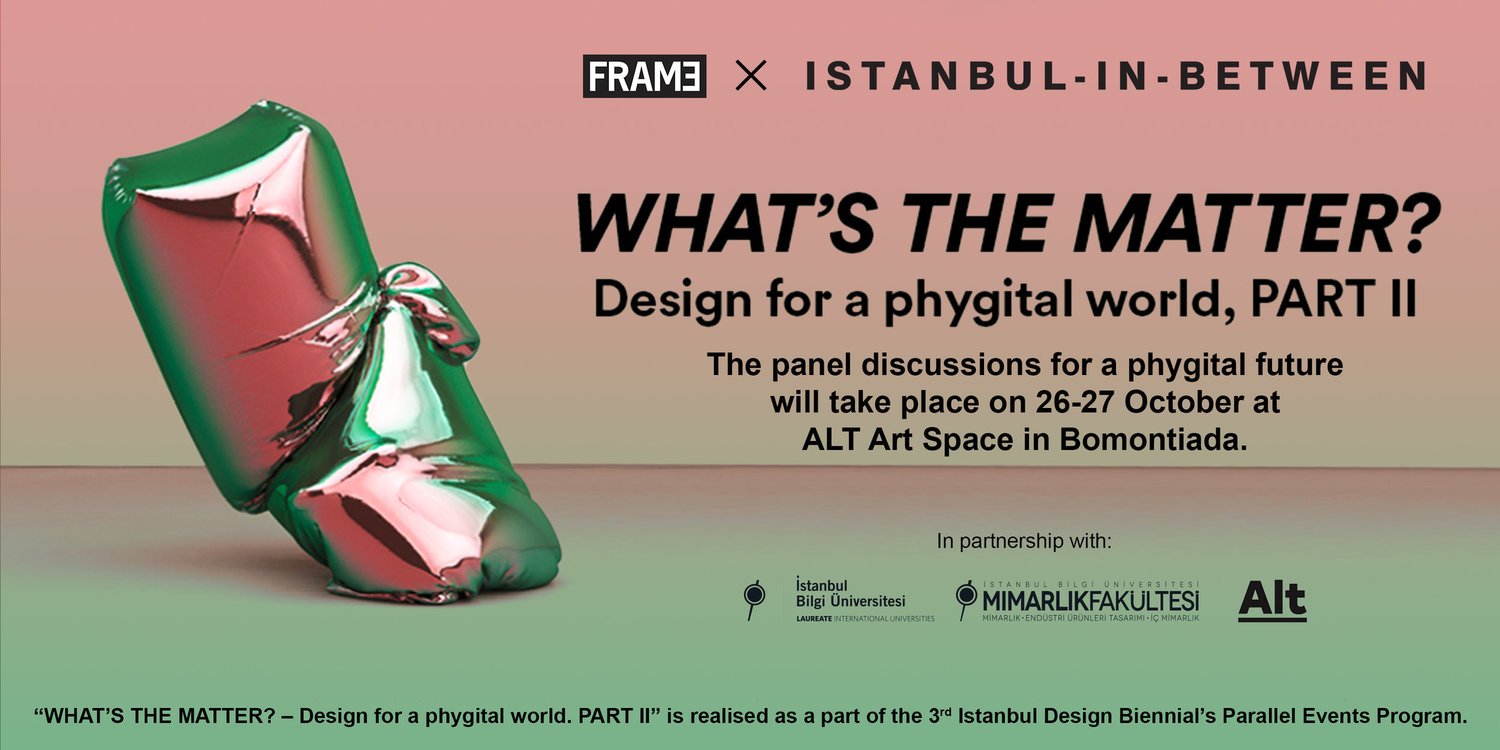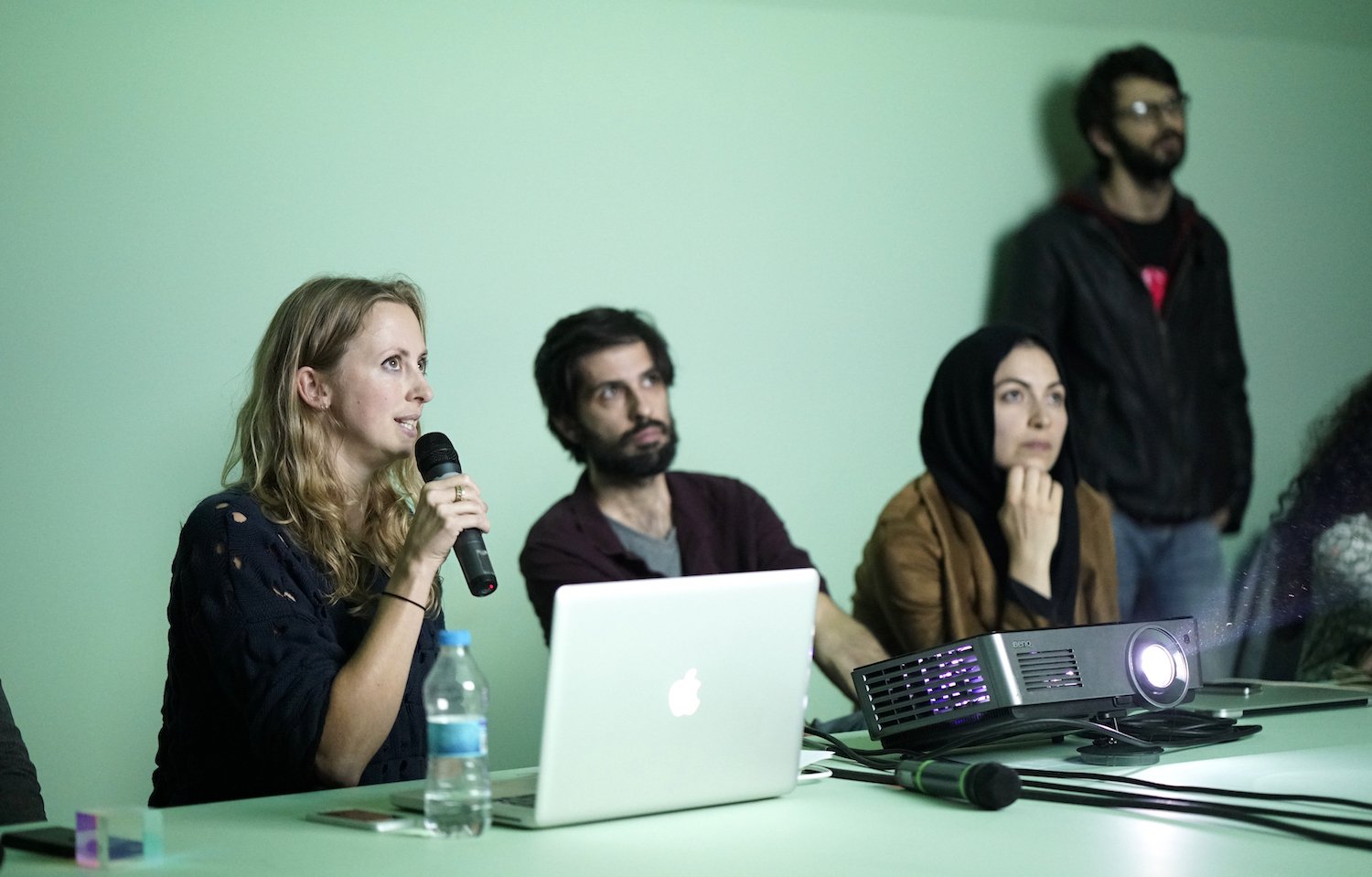Phygital panels discussed how we become makers by using basics of physics
“Design for a phygital world” panel series were organised in partnership with Frame Magazine as a part of the 3rd Istanbul Design Biennial’s Parallel Events Program.
Last week has been very exciting, productive and intense for us. As ISTANBUL-IN-BETWEEN, we teamed up with Frame Magazine and created a panel series with interdisciplinary artists & designers about a theme which we’ll be hearing more and more in the upcoming days: “Phygital”.
“Phygital” comes from the combination of two words, physical and digital, and questions the relationship in-between these different and yet mutual worlds regarding to design. During the panel, we focused on what physical and digital productions have in common, when one turns into the other and how their aggregation effects our lives. We discussed the physical objects that enable the digital connections, using basic rules of physics to mimic holograms, playing with the optical forms and by doing this how we actually become a maker. This process also encourages us to share our knowledge and experience through the web.
The panel series took place at ALT Art Space in Bomontiada as a part of the 3rd Istanbul Design Biennial’s Parallel Events Programme. In partnership with Frame Academy Program, Istanbul Bilgi University Department of Industrial Design The State of Design studio students created six exhibition units that stimulate the phygital theme. We invited international designers, artists and initiatives to share their knowledge and experience through this new notion in the fields of digital technologies, sound, product design, architecture, film, animation and many others.
Jordan Söderberg Mills, taught as a blacksmith, is a maker hacking our perceptions by using the basics of physics. Jordan believes in that “The true beauty of an object lies in transition.” Thus, he uses the illusion of light to create tangible objects. He utilizes light as a solid material and plays with it to give a sense of volume. His way of defining digital doesn’t depend on computer programmes. For example, some of the prisms contain RGB channels but doesn’t necessarily need Photoshop to create these effects. Or he uses lenses to juxtapose different photographs to create physical filters that works as the same as phone applications. By using mirrors for reflections, the color scale of the light and the features of the optics, he manually turns the digital realities into physical objects.
Selçuk Artut, with mathematics and media communication background, started his talk with “the third eye” topic. If you have the third eye, where would you position it? Then he explained the answer as our mobile phones and continued his talk with the world of graphics as a non-reality in our everyday lives. Artut explained the “soul of mechanism” with the mechanic dolls manufactured in the 17th and 18th century in Switzerland and Japan as non-digital but phygital examples. He continued his talk with ”What You See is not What You See” an augmented reality installation he produced in 2014.
Bastiaan de Nennie gets inspired by the objects in our daily life, the ones we see in the living and working spaces or even on the streets, plays with them, cuts them into pieces and turns them into digital creators. He scans the objects with 3D scanners to create a material future and he even gets a step further by printing the research process. The objects of 3D totem, stroll between digital and physical worlds, and get transformed into new form and appearances each time. With this method, Bastiaan closes the gap between the two mediums and offers a phygital world where they both matter the same.
Aslı Serbest, an architect exploring space through digital medias together with her partner Mona Mahall at m-a-u-s-e-r, started her speech with the material culture of the internet. She explained her “Natural Wifi” project as a physical state of technological existence. “Natural Wifi” is investigating the techno-landscape of Los Angeles, by placing a fake palm tree and a stone to reflect the role nature plays in architecture.
Simge Hough and Dilek Öztürk, tutors of The State of Design Studio at Istanbul Bilgi University Department of Product Design explained the studio process realised in partnership with Frame Academy Programme. For this project, Frame commissioned 3rd and 4th grade design students to design, build and manage a pop-up store which took place in the panel series. The student design team had to rethink the changing working culture and formulate an interactive spatial design based on the idea of creating a community – questioning how an event/exhibition space is related to the product and its consumers, and how the space functions within the dynamics of the Istanbul Design Biennial.
Yoğunluk is an initiative founded in 2013 by İsmail Eğler, Nil Aynalı Eğler and Elif Tekir that focuses on recalling the existential reason of the spaces while producing art. Their works get formed in three steps—discovering a unique space, developing a concept that shows the unseen parts of site and inviting people to contribute and experience. They try to make the bridge between physical and digital visible, and digital is the tool to achieve what they want to externalize.
Together with architect and transdisciplinary artist Buşra Tunç, Yoğunluk created Su Ruhu, a site-spesific installation located in an old cistern. The work stimulates the old feeling by using light and water as physical, and the recorded sounds as digital materials. With this immerse experience of water, the space starts to breath again.
Alice Dunseath, a London based filmmaker and animator, creates an interpretations of perceptions by using physical and digital tools at the same time. She thinks digital has the same value as the physical. She uses different materials, chemicals and elements to create visual realities, and completes them with the matching sounds to make the sensations more real for the audience and start an interaction not only with the eye but also with the ear.
Osman Koç, a creative technologist and new media artist based in Istanbul, explained his approach to phygital by visualising data, sound, behaviour in specific spaces. He started his talk with one of his latest projects; 3D printed prothesis in partnership with Robotel. Robotel is a custom 3D printed practical solution for kids enabling them to have hand or finger movement. Osman explained the process as he never used one simple tool of technology to 3D print the prothesis by downloading all the necessary data on the web.
All the panelists with different backgrounds use different systems, technics and processes to achieve a point where they find their own way to work in between digital and physical worlds.
By manually turning the digital realities into physical objects or using kinetic tools to enable digital connections, we can see that the existence of technology still allows us to work “hands on” and collaborate with more and more people in different disciplines and thus, promote a new way of creative-socialising.
THE PROGRAMME
WHAT'S THE MATTER? – Design for a phygital world. PART II at ALT, Bomontiada
Moderator: Dilek Öztürk, Co-Founder, In-Between
Welcome speech by Marlies Bolhoven, Head of Partnerships and Events, FRAME Publishers
26th of October 18:00 - 20:00
Selçuk Artut, Artist and interactive designer
Simge Hough, Designer and academician
Bastiaan de Nennie, Visual and product designer
Aslı Serbest, Architect, artist and researcher
27th of October 18:00 - 20:00
Alice Dunseath, Filmmaker and animator
Osman Koç, Technologist & artist
Jordan Soderberg Mills, Interdisciplinary artis
Yoğunluk, Interdisciplinary artist initiative












